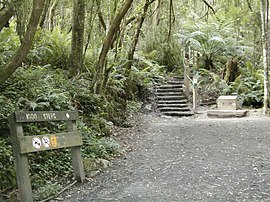| Ferntree Gully Melbourne, Victoria | |||||||||||||||
|---|---|---|---|---|---|---|---|---|---|---|---|---|---|---|---|
 The 1000 Steps Kokoda track | |||||||||||||||
 | |||||||||||||||
| Coordinates | 37°53′10″S 145°16′56″E / 37.8862°S 145.2821°E | ||||||||||||||
| Population | 27,398 (2021 census)[1] | ||||||||||||||
| • Density | 1,960/km2 (5,070/sq mi) | ||||||||||||||
| Established | 1880s | ||||||||||||||
| Postcode(s) | 3156 | ||||||||||||||
| Elevation | 150 m (492 ft) | ||||||||||||||
| Area | 14 km2 (5.4 sq mi) | ||||||||||||||
| Location |
| ||||||||||||||
| LGA(s) | City of Knox | ||||||||||||||
| State electorate(s) | |||||||||||||||
| Federal division(s) | Aston | ||||||||||||||
| |||||||||||||||
Ferntree Gully is a suburb in Melbourne, Victoria, Australia, at the foothills of the Dandenong Ranges, 30 km east of Melbourne's Central Business District, located within the City of Knox local government area. Ferntree Gully recorded a population of 27,398 at the 2021 census.[1]
Ferntree Gully, The Basin, Boronia and Upper Ferntree Gully are the only Dandenong Ranges towns or suburbs in the City of Knox (although some parts of Upper Ferntree Gully are within the Shire of Yarra Ranges). The City of Knox is one of the few cities not broken-up during the Kennett government review of councils and had its area expanded to include parts of Upper Ferntree Gully that were previously in the Shire of Sherbrooke (now part of the Yarra Ranges Shire).
Ferntree Gully and Belgrave are closely linked in many ways. Ferntree Gully is younger than Belgrave (Belgrave being established in 1851 and Ferntree Gully in 1880).
Ferntree Gully has many Eucalyptus trees (gum trees) and lies at the foothills of the Dandenong Ranges. Its boundaries meet Upper Ferntree Gully, a separate but similarly named suburb with the same postcode, Boronia to the North, Scoresby to the West and Lysterfield to the South. The eastern boundary coincides with the Ferntree Gully National Park which is a National Park administered by the Federal Government. Ferntree Gully is in a high fire risk area in the vicinity of the Ferntree Gully National Park, however the majority of the suburb is considered low risk.
- ^ a b Australian Bureau of Statistics (28 June 2022). "Ferntree Gully (Suburbs and Localities)". 2021 Census QuickStats. Retrieved 14 July 2022.
